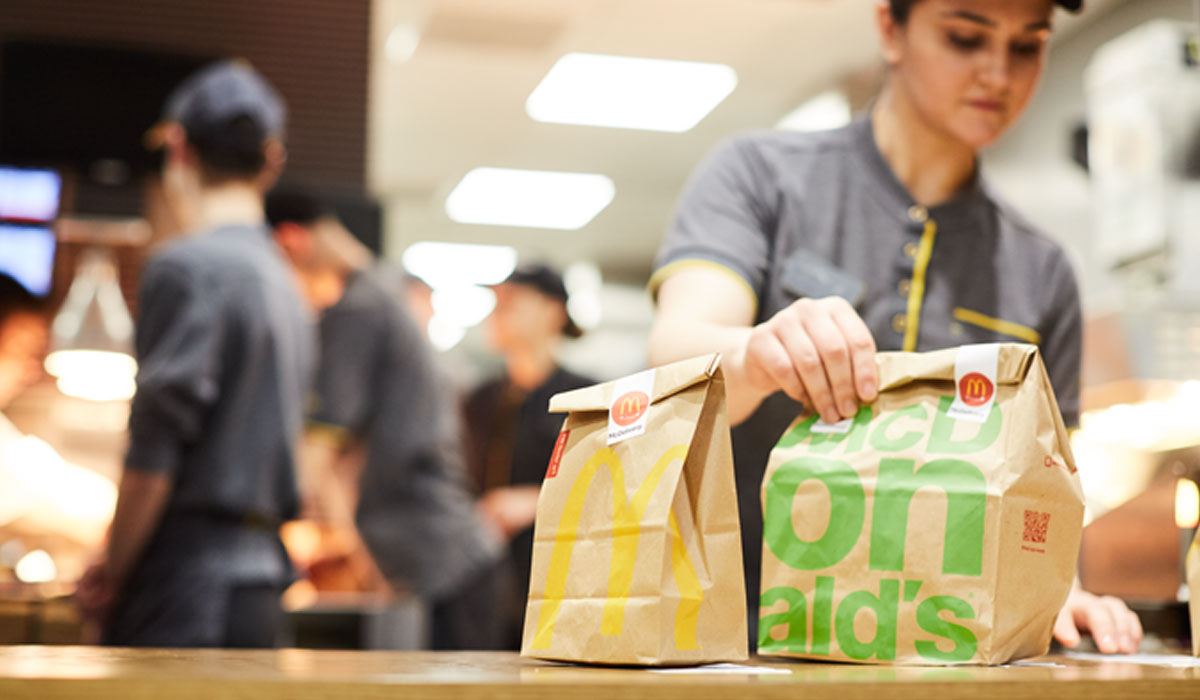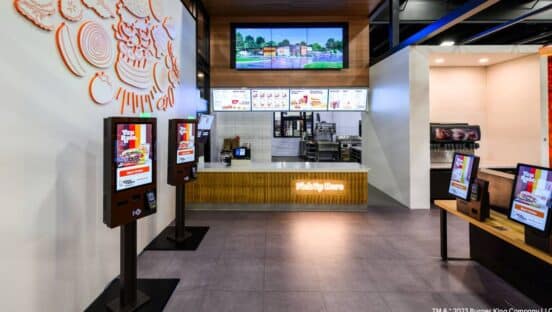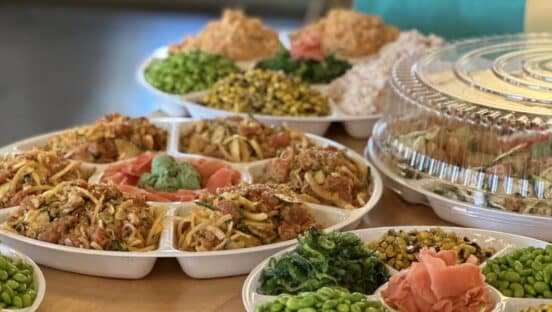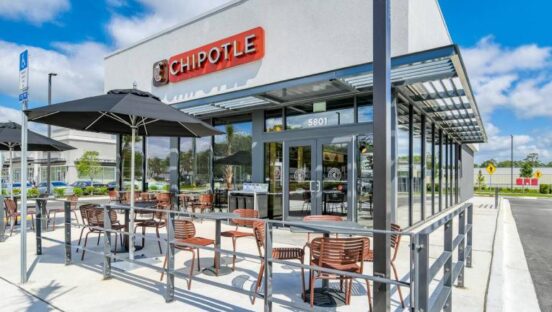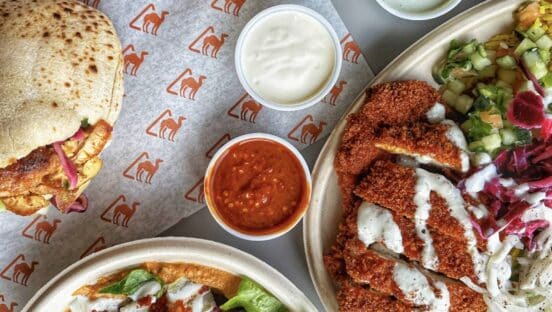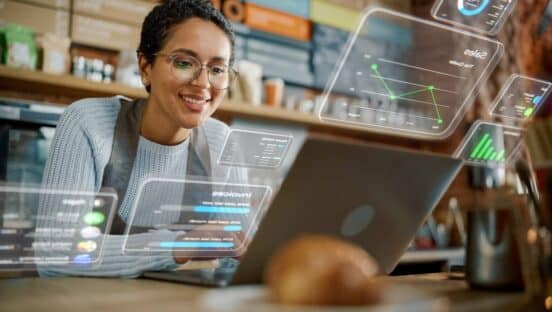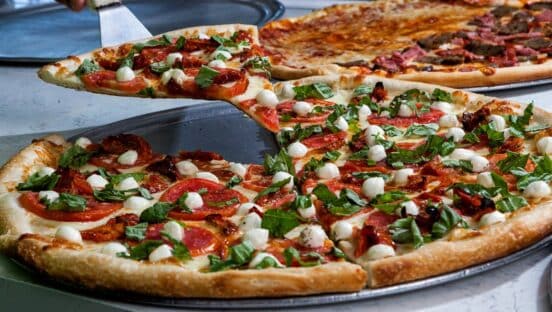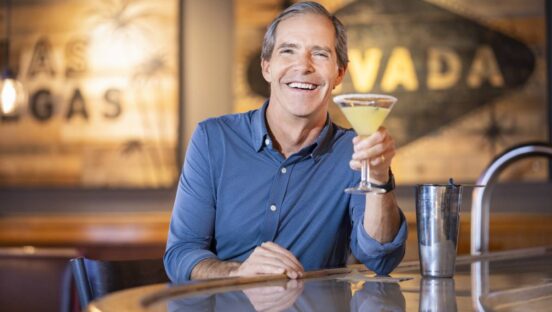Few topics felt the COVID-19 tailwind more than delivery. In the U.S., the category’s share of foodservice sales doubled to more than 15 percent, according to financial services company Rabobank. And even as delivery catches its breath, the group expects 2022/2023 to usher in a fresh era of growth, with sales sticking 40 to 80 percent above 2019 figures in nearly every major market.
As always, though, delivery isn’t a simple numbers game.
Will an unprecedented rise prove incremental to overall industry sales? There’s reason to think it won’t. In which case, the implications will be significant, and perhaps one of the true lasting imprints of the global crisis.
Understanding the present, imagining the future
There’s little confusion why delivery swelled in 2020, with domestic channel sales climbing nearly 75 percent: Dine-in exited the picture. As did many restaurant concepts that couldn’t sustain operations, or decided to wait it out. Fewer options in a suddenly less-saturated field.
According to Datassential’s Firefly platform, 90 percent of customers said they changed delivery behavior as a result of COVID.
Just in terms of adoption, the category exploded out of the trough.
The number of limited-service salad, dessert, and sandwich segments offering delivery increased 42.9, 40.2, and 28 percent, respectively, from June 2020 to December 2020. Quick-service Mexican upped 23.4 percent, chicken 20.1 percent, burger 15.5 percent, and pizza 14.2 percent.
All of these categories, outside of dessert (66 percent) were north of 73 percent coverage by the time 2021 rolled around.
In the year ending March 2021, restaurant digital orders ballooned 124 percent compared to the prior year, according to The NPD Group. Digital orders for carryout, which represented 62 percent of all digital transactions, jumped 130 percent. Digital orders for delivery lifted 140 percent.
Even quick service, a segment responsible for 84 percent of the industry’s share of digital mix pre-coronavirus, realized triple-digit growth of 111 percent (full service soared 237 percent).
With delivery, digital orders through third-party apps lifted 207 percent in the period versus year-ago compared to a 98 percent increase in digital business that came via restaurant apps and websites.
“It’s unlikely that digital ordering will grow at the same pace it has during the pandemic once restaurants fully open, but it’s table stakes for restaurants now,” David Portalatin, NPD food industry advisor and author of Eating Patterns in America, said in May. “Digital ordering is all about elevated convenience and ease and that’s what makes consumers tick.”
Given the progress, and to Portalatin’s point, it’s easy to assume delivery’s 2020 share gains will reverse somewhat in 2021. The story, however, will be what comes after. Rabobank believes delivery—in 2022 and beyond—will appreciate structurally larger market share and size than it did in 2019.
Specifically, in the U.S., 2021 delivery sales are expected to decline double-digits but remain nearly 50 percent above 2019 levels, and grow far in excess of overall foodservice sales over the next several years. Also, the delivery landscape will undergo an even bigger change as aggregators consolidate and blanket the space, raising their share of overall delivery sales from 37 percent in 2019 to likely over 70 percent in 2023, Rabobank said.
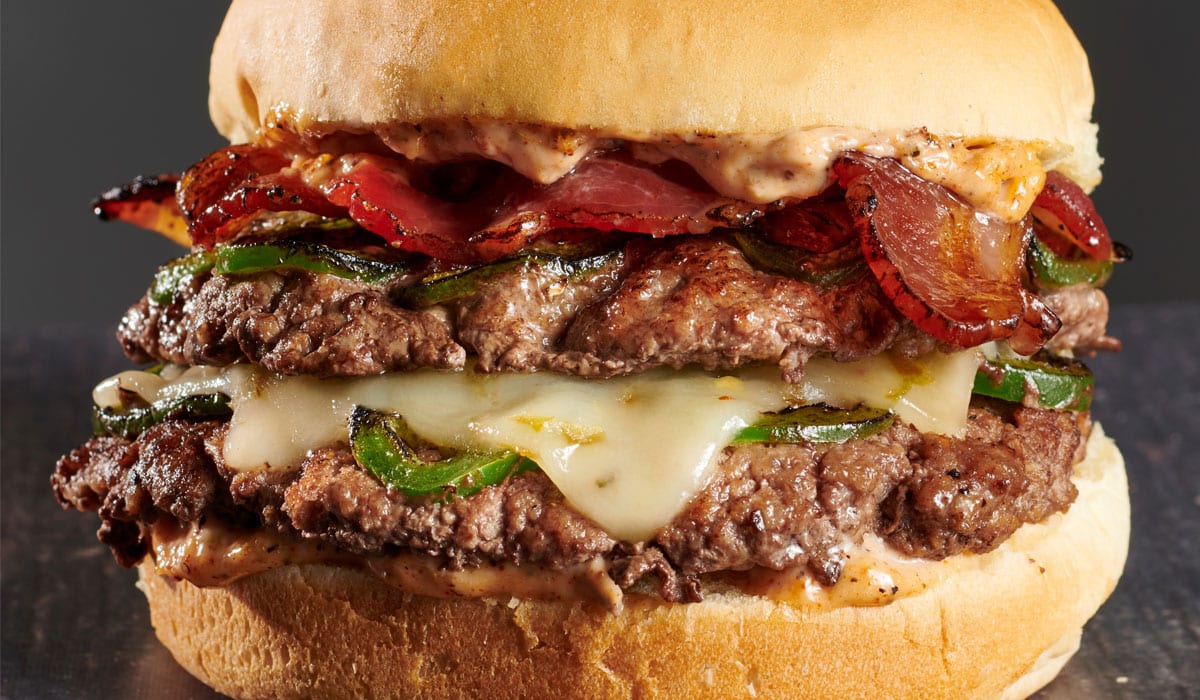
This is a trend worth circling. While restaurants continue to invest in white-label options and work to regain control of data and experience, aggregators have done nothing but balloon reach in the past year. For all of Grubhub’s challenges with profitability, it hasn’t struggled to prove demand. The aggregator’s gross food sales hiked 60 percent, year-over-year, in Q1 to $2.6 billion. Daily average orders lifted 44 percent to 745,700. Grubhub also reported 33 million active diners—1.5 million more than the previous quarter. Strikingly, a full 9 million more than Q1 2020.
In Datassential’s study, 40 percent of guests said they used third-party for delivery. Twenty-seven percent picked “phone,” 21 percent “restaurant website,” and 12 percent “restaurant app.” More than 60 percent of Baby Boomers said they’d rather use a phone than go online.
What’s also important to factor is COVID forced existing operators to review strategies and find ways to incorporate delivery in an effort to meet this demand. But it also inspired new brands to come to market with a delivery-focused strategy from inception. Ghost kitchens, virtual food halls, and the like.
Is there a structural limit to how high delivery’s share of total foodservice sales can be, even across a longer-time horizon?
In full service, particularly fine dining, opportunities for social interaction will limit delivery penetration to a certain extent, Rabobank said. Meanwhile, the prevalence of cheaper off-premises channels, like pickup and drive-thru—also beneficiaries of COVID’s clamp on dine-in—will curb delivery’s growth across counter service.
Convenience is the great equalizer. Respondents told Datassential they expected to wait 33 minutes or less. Forty-seven minutes or more and they start to get annoyed.
The economics for take-away and drive-thru win out for restaurants as well, and efforts to foster them will balance the future.
Chipotle is one of the most vivid examples. As of March 31, the fast casual boasted a total of 196 stores with order-ahead pickup lanes. Trailing 12-month “Chipotlane” restaurants drove 17 percent higher overall digital sales than traditional locations. But more notably, order ahead was nearly 80 percent higher and delivery about 30 percent lower.
Chipotle, to that date, raised delivery prices roughly 17 percent to offset costs and ease margin pressure.
It’s crystal then why more than half (26) of its 40 openings in Q1 included a Chipotlane, and why the company said 70-plus percent of 200 projected new stores in 2021 will feature one. BTIG analyst Peter Saleh went as far as estimating Chipotle could have as many as 1,000 drive-thru locations by 2025. Today, there are about 400 free-standing and nearly 1,600 end-cap Chipotles. Past new growth, there’s plenty of candidates for conversions.
Rabobank provided another comp. A deeper look at the cinema/box office industry suggests a cap on consumers’ trade-off between social/immersive experience and convenience. Despite wide availability of streaming (call it a proxy for delivery), the number of tickets/admissions has remained largely steady over the years. Concert sales have not suffered from the wide availability of CDs or streaming, either.
As the experience factor remains vital for restaurants as well, Rabobank said, delivery will only serve as a substitute for foodservice spending driven by convenience.
This brings forth the earlier question—will delivery drive incremental growth? Before COVID, global foodservice sales increased at a compounded annual growth rate (cagr) of 3–4 percent over the last three, five, and 10 years, respectively. This is a relatively consistent line, even as delivery growth accelerated from an 11 percent CAGR between 2013 and 2016 to an 18 percent CAGR between 2016 and 2019, doubling delivery’s share of total sales from 4.2 percent in 2013 to 8.4 percent in 2019 (and 14.6 percent in 2020).
Pre-coronavirus, traffic and on-premises sales were going in the opposite direction, perhaps at the expense of this growth. The category’s share declined consistently from 73.8 percent in 2013 to 68.6 percent in 2019. It was 52.8 percent in 2020, a strange year to measure against.
In Rabobank’s view, food delivery does not appear a serious substitute for home-cooked/ready meals from supermarkets. Not unless the price of a meal delivered drops to a comparable level. The rise of larger, well-capitalized delivery platforms/aggregators and better packaging might improve the overall experience and attract new and repeat users. However, foodservice is more likely to remain a zero-sum game with delivery largely taking share from other channels rather than generating substantial incremental sales.

There’s compelling evidence to support the notion:
A dive into 16 of the largest global foodservice markets suggests faster delivery growth doesn’t necessarily drive stronger growth for the entire category. Total foodservice sales growth, in fact, shows very little positive correlation with either delivery growth (plus 35 percent) or the size of delivery (plus 36 percent) in these markets.
Before 2020, total foodservice growth was flat or lower in 10 of the 15 markets over the last three years compared to the previous three-year period. This even as delivery’s share of total sales in these areas jumped 250–300 basis points.
Next, tech-enabled disruptions/changes in many other consumer categories failed to materially lift long-term growth trajectories. Example, Amazon. The behemoth’s share of U.S. retail sales increased from 2.5 percent in 2015 to 5.9 percent in 2019. It’s outgained the category by 24 percent over that stretch.
However, still, it hasn’t had much impact on the overall retail sales growth trajectory, as U.S. retail figures posted a 3.3 percent CAGR during this period—largely in line with the 3.8 percent CAGR over the 2010–2015 window.
A third point: Over the longer term, foodservice sales tend to show much tighter correlation with the macroeconomic environment, particularly disposable income, GDP growth, and unemployment levels. Domestic foodservice consumption revealed a nearly plus-74 percent correlation with per capital personal consumption expenditure over the past 25 years, including less than 90 percent correlation during recessionary stretches, Rabobank said.
As a result, the food-away-from home share of total disposable income increased at a fairly steady rate over the last 10, 20, 40 years—from 2.2 percent in 1979 to 6.3 percent in 2019.
To put it simply, while the rate picked up a bit recently, rising delivery sales are unlikely to materially alter this trajectory.
What does it all mean?
Rabobank’s projection that foodservice sales through delivery will be structurally larger in the future, and that most growth will not be incremental to total foodservice sales—suggesting something will give in response—has significant implications.
Yet that’s not to say the impact will be uniform. For brands where consumer experience and personal connection reigns, delivery will inch back in the coming years to a relatively marginal part of the business. And the debate over whether the pros and cons balance will spring back to the forefront. It won’t mirror COVID, a time when restaurants did everything they could just to get food to customers.
Regardless, most restaurants won’t be able to skirt the growth of delivery. A large part of foodservice spending is—and will continue to be—driven by convenience related to either occasion (say replacing cooking at home or eating at work) or time and effort. It could be value inspired, too.
In these cases, which is the world quick-serves often reside in, the added value of sitting down at a restaurant or even picking up food personally, can be limited. And so delivery’s opportunity to snatch share from dine-in will continue.
There are scenarios as well where delivery lowers barriers to entry for new competitors and startups by limiting initial CapEx. No need to invest in a site with seating space and worry about prime real estate, as evidenced by COVID breaking the dam on virtual concepts and ghost kitchen expansion. An entrepreneur can now just rent a small space and get to work.
Labor costs are lower. No waitstaff. Further, the absence of a pre-established physical presence is less of a headwind today thanks to how customers find food. Guests are far more adept at search and quality-control strategies using third-party platforms, social media, and online reviews.
Additionally, back to the ghost kitchen lure, some established operators have incorporated delivery-only brands to their offering and from their existing sites. In other cases, operators with established concepts extend their catchment area beyond historic reach via delivery.
Chicago-based Wow Bao has been one of the banner brands over the last year-plus of COVID. The concept, founded in 2003, passed 100 locations nationwide in a six-month timeframe through a program (developed prior to the pandemic) aimed to assist restaurants and increase margins and profits. Essentially, unlike ghost kitchens, which allow concepts to rent spaces at larger kitchen facilities, Wow Bao’s model offers brick-and-mortar restaurants alternative sources of revenue by using their existing kitchen space to prepare Wow Bao’s menu. The product is made and shipped frozen to participating restaurants, prepared by the restaurant’s kitchen staff, and then made available to consumers through third-party delivery service.
“While we are very excited about the hockey stick growth we have achieved thus far, our team is most proud of the help we have provided our dark kitchen partners,” says Geoff Alexander, president and CEO of Wow Bao. “Although we created ‘Wow Bao Now’ pre-pandemic to help restauranteurs grow topline sales and increase bottom-line profits, it has been extremely rewarding to have helped keep the lights running for so many.”
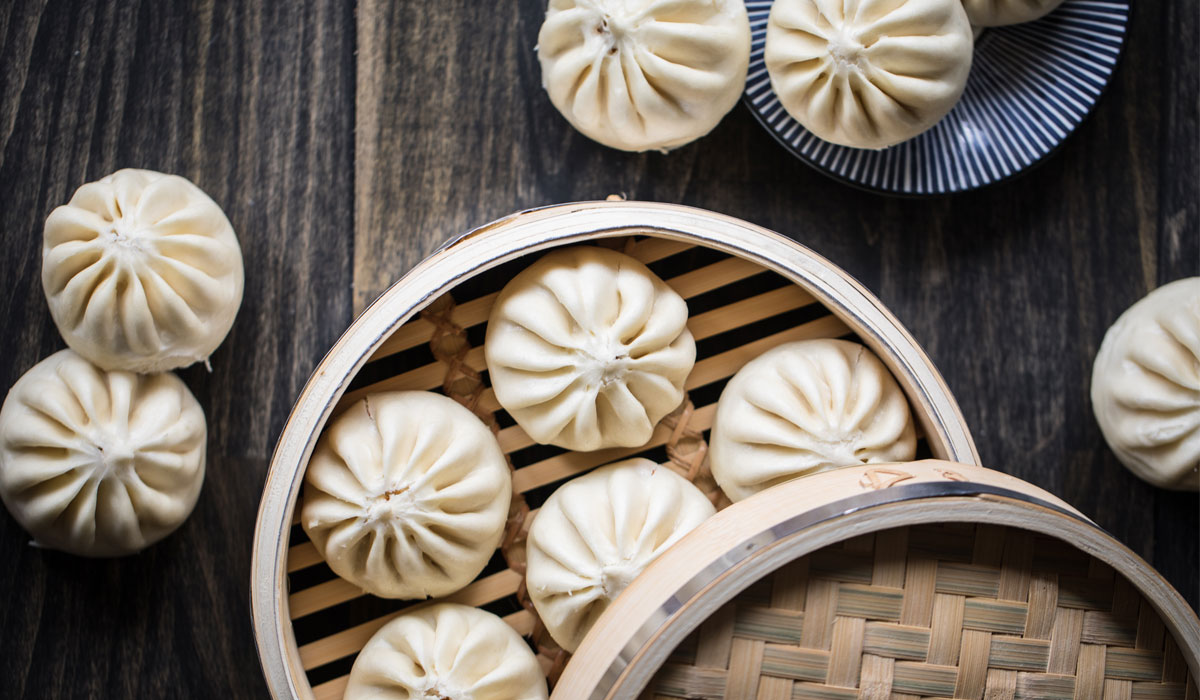
Some operating partners surpassed $5,000 in weekly sales from the arrangement, the company said in October, generating an annual run rate of $260,000 with a projected bottom line of more than $100,000.
Wow Bao crossed 300 of these by April and believes it can surpass 1,000 locations within the next year.
Strategies to adapt
COVID forced the delivery hand for a lot of restaurants. Brands jumped in because they had no other lifeboat. It went behind fear of ceding share; it was the only outlet. Sign up, figure out the profitability later.
It’s time to rethink those strategies, however, Rabobank said. To make delivery truly work, processes and menus need to be adjusted. Assembly speed must be higher than is the case with table service, and dishes have to consider portability.
The result, for many operators, is delivery will require menu simplification, as has been the case across the spectrum—from Outback’s pared-down, steak-centric menu unveiled in August to McDonald’s making the call a year or so ago to cut items, including All-Day Breakfast. Joe Erlinger, president of McDonald’s USA, said in Q1 the chain’s ability to drive customer visits began “with committing to the core menu.” He noted McDonald’s removed “dozens” of items early on during the pandemic. In turn, drive-thrus got faster, margins grew, and customer satisfaction improved.
In Rabobank’s view, simplification scores with delivery just as it does with drive-thru. Dishes need to stay fresh for at least 30 minutes. And they should not depend on their presentation or be sensitive to temperature changes, requiring different ingredients and high-quality packaging.
A lot of restaurants will be able to make these adjustments from existing facilities. Others might need to invest in selected sites focused on delivery (perhaps even to-go)—the aforementioned “dark kitchens.”
In cases of having extra space in the restaurant—something that’s come up a lot in recent months with depressed dine-in sales—as well as limited delivery demand for a specific concept’s cuisine, becoming a host kitchen has taken on relevance. It’s Wow Bao’s model from the other angle. Brands can rent space and time slots to third-party operators or incorporate self-operated virtual brands. These can be proprietary or third-party, with outsourced or in-house delivery.
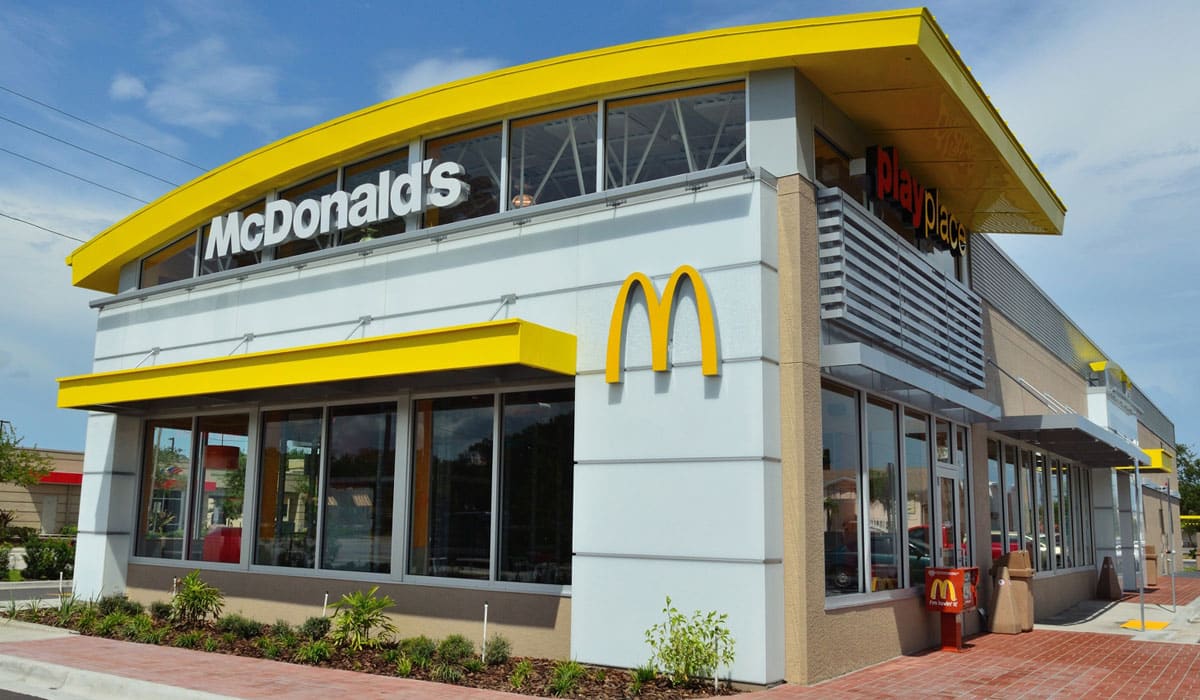
MrBeast Burger erupted across about 600 local restaurants from December to April. Restaurants, like full-service brand The Greene Turtle, signed up to serve as a host kitchen for the virtual enterprise, named after YouTube star Jimmy Donaldson. He joined forces with Virtual Dining Concepts, co-founded by restaurateur Robert Earl, to offer existing operational kitchens another brand to execute via off-premises.
VDC provides training and recipes, as well as ingredients, packaging, and marketing support.
Another illustration is Franklin Junction, which grew to more than 500 host kitchens and 20 brands partners within a year. The company labels itself “an innovative foodservice e-commerce solutions platform that matches underutilized kitchens with proven restaurant brands for incremental revenue opportunities.”
The key note there, unlike ghost kitchens, is a platform like Franklin Junction’s “Host Kitchen” does not require new infrastructure to be built.
More on the future
As delivery’s reach expands further, restaurants will continue to tap the channel as a low-barrier expansion strategy. An increasing number of established concepts use “delivery only” as a first step in growth.
Famous Dave’s responded to COVID with ghost kitchens, dual kitchens, and virtual brands. CEO Jeff Crivello said this allowed the chain to vet markets ahead of potential physical infrastructure. Kind of like how a food truck hits the road and morphs into a small trailer before deciding there’s enough demand to go brick-and-mortar.
Famous Dave’s said earlier in the year it expects to add ghost operations inside 25 Johnny Carino’s restaurants. And these are in many states where the barbecue brand doesn’t have a presence yet.
Suddenly, the chain will be in Texas, Idaho, Arkansas, Louisiana, Kentucky, Indiana, and California.
Crivello said there’s a chance these ghost kitchens morph into dual concepts (add Famous Dave’s branding out front). But if they don’t, no great loss.
“At least you didn’t build out a million-dollar restaurant just to test out that territory,” Crivello says. “Not only are we able to tap into and broaden our Famous Dave’s footprint into many other geographies, we’re able to get a very good look into regions we should be building physical infrastructure.”
Famous Dave’s was also part of a May launch with Pepsi where the company created “Pep’s Place,” a “fast-beverage” virtual brand that started operating mainly out of Famous Dave’s buildings.
Restaurants can use a delivery-only strategy to test demand for new menu items or take advantage of a booming trend. Say Chili’s “It’s Just Wings” or Nathan’s “Wings of New York.” Nathans opened 100 ghost kitchens—offering its traditional menu and the new virtual wings concept—from June to February.
In addition to Franklin Junction, Nathan’s Famous partnered with REEF in 2020 to expand across the U.S. alongside the company’s independent fleet.
“Our ghost kitchen strategy was developed six months prior to the start of COVID,” says James Walker, Nathan’s SVP of Restaurants. “We put a lot of thought and energy into the plan and subsequent execution of both Wings of New York and Nathan’s Famous and we attribute our success in the space to three things, strong customer demand for our brands, a well thought-out strategy and selecting the right operating partners.”
[image source_ID=”129595″]
Even some third-party platforms started ghost kitchens, like Deliveroo Editions and DoorDash Kitchens. Restaurants can sublease space and the aggregator takes care of kitchen appliances, utilities, and cleaning. What’s the potential downside of some of this? While virtual brands allow for innovation and quick menu changes, they are difficult to grow and maintain, Rabobank said. Face-to-face contact with customers is missing. Brand equity is generally tougher to build. “Especially when a virtual brand is making use of host kitchens, they run the risk of reputation damage if a host kitchen does not manage the orders well,” the company said. “Virtual brands are likely also the first thing a host kitchen will divest once capacity is needed for their own restaurant offerings.”
As Chili’s CEO Wyman Roberts said in Q3: “I think the thing that doesn’t get talked about the most, it’s probably the most important, is what is it doing to your base business? And are you able to pull this off? And I’ve seen examples of people growing maybe three or four virtual brands, and it’s just very, very hard for me to imagine how that executes from an operational standpoint. And sometimes, as they talk about simplifying their menu and their base concept, they just don’t kind of go together. So you have to be very diligent about all of that to make it work both from a brand standpoint and from a consumer perspective.”
In October 2020, 35 percent of guests said they had virtual brand awareness and 23 percent ordered from one, Datassential found. By March 2021, it was 50 and 34 percent, respectively.
Ninety-two percent said they wanted virtual brands properly identified on delivery apps, with 73 percent adding they’d like to know which restaurant/kitchen is preparing the food.
It bears asking, will trust win out in the end? And can you target that with brand association over novelty?
Supply changes
There’s little doubt on-premises consumption will still dominate foodservice demand in the future. However, the expected share of delivery in total foodservice will be significant enough to trigger changes beyond the industry and into its value chain.
Rabobank believes delivery will accelerate evolution in suppliers’ client bases that will include larger customers with greater bargaining power. Restaurants will also demand different products and in different formats, prioritizing choices that facilitate their work in the kitchen, products, and ingredients for dishes formulated to endure traveling. As well as value propositions that help operators manage costs.
Essentially, for some foodservice operators, the expansion of delivery means additional pressure on profitability, either because they lose revenues to delivery or because they need to accommodate the cost of delivery in their business model. And so restaurants will take another look at food costs.
Delivery’s growth could benefit chains over independents as they use scale to better position in the race for guests. For wholesalers and distributors focusing on the foodservice market, this may result in a reduction of the number of clients, Rabobank said, as large chains bypass intermediaries and directly approach food producers.
In other cases, their restaurant clients are also likely to be more demanding, because they are larger and have more bargaining power, or because, being under pressure themselves, they are more critical regarding their own costs. On the positive side, packaging suppliers will welcome volume and value growth opportunities. With delivery, packaging becomes the best path to communicating brand identity. Additionally, it’s now one of the most visible and impactful methods to promote sustainability.
What’s clear, beyond all nuances, is delivery is going to reshape the restaurant landscape on the backside of COVID. If anything, the pandemic hastened what was already coming. The “new normal” in the end might be something operators are plenty familiar with—convenience. Only elevated into a more accessible and disruptive realm than ever.

